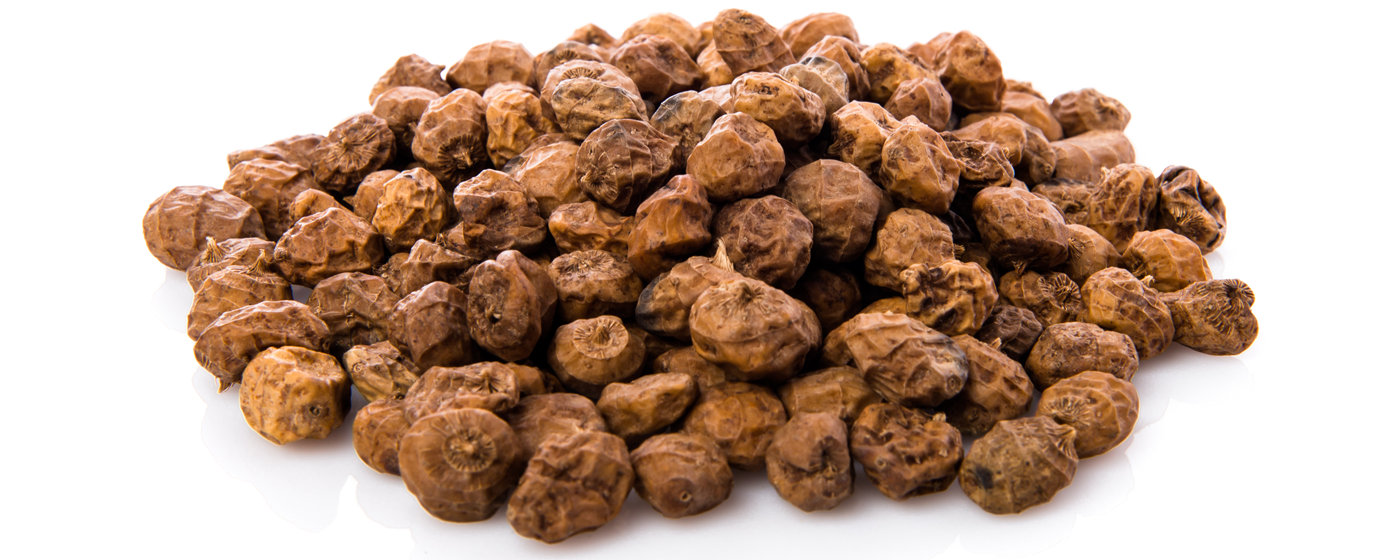Tiger nut
The tiger nut is a root vegetable known since Antiquity which now exists throughout the world. This perennial non-hardy plant is cultivated in Europe, notably in the region of Valencia, in Spain. The Spanish use it to make Horchata de chufa, a refreshing, almond-flavoured drink.
The tiger nut: from ancient cultivation to weed
Egyptian sarcophagi reveal that the tiger nut was already cultivated around 2400 BCE. The thick pyramid walls actually prevented the tubers from deteriorating.
Its cultivation subsequently spread all around the Mediterranean. Tiger nuts are mentioned in classical and 17th century literature; they are also referenced as a highly-prized food in Great Britain in the 19th century, when they were called Zulu Nuts, after the Zulu people in South Africa.
The tiger nut was introduced to the United States in 1845 but has been in gradual decline since the early 20th century. Today, this tuber is grown in California and in the Southern States, as well as in Spain. It yields ten tonnes per hectare in Spain, mainly in Horta in northern Valencia. Elsewhere, the tiger nut is considered to be a particularly invasive plant and practically impossible to eliminate.
A cousin of the papyrus plant
The tiger nut, Cyperus esculentus L., is a perennial plant, ochre to brown in colour, with white, slightly floury sweet flesh. It has an almond flavour which becomes stronger as it dries. It enjoys fresh, light, even sandy soil that is sunlit. Tiger nuts are harvested in October and November.
The best places for storing the tubers are buildings with particularly thick walls or in metal containers. Edible tiger nut plants can be ordered online and grown at home.
The tiger nut and its many uses
The main product made from tiger nuts is a Spanish plant-based milky drink with a taste somewhere between almond milk and soya milk. It is called Orxata de xufa in Catalan and Horchata de chufa in Spanish. Ice cream is also made from it. Chufa de Valencia products have been awarded an AOC label, guaranteeing that they are made 100% from plants.
Tiger nuts can be eaten raw, cooked, grilled, boiled, dried, rehydrated or ground into powder or flour. Roasted tiger nut seeds are used to produce a coffee substitute, especially in Hungary. Various tiger nut products and their proven nutritional properties are particularly popular with coeliacs and diabetics, as tiger nuts are gluten-free. They are also good for people who are allergic to nuts and almonds. Tiger nut tubers are also used as bait, especially for carp fishing in Great Britain, but they do need some prior preparation.
Nutrition
Tiger nuts are among the rare plants whose roots contain fat (over 20%). They consist of 50% carbohydrates (sucrose and starch), 22% fat (in particular 18% unsaturated omega 6 and omega 9 fatty acids), 6% to 7% protein, minerals (phosphorus, calcium, potassium, magnesium and iron) and fibre and are also very rich in antioxidant vitamins E and C. They provide 460 kcal per 100 g.
Tiger nut oil contains almost 70% oleic acid and is thus similar, nutritionally speaking, to olive oil. It is used in cosmetics, perfumery and pharmaceuticals and in the textile industry (for waterproofing).
The legendary name of horchata
Legend has it that the name of the Spanish drink Horchata goes back to James I of Aragon. He reportedly said, “Això és or, xata” (“This is gold, little one”) in response to a child who offered him this drink during his conquest of Valencia.
DAVIDSON, Alan, 2006.Chufa in: The Oxford Companion to Food. New York: Oxford University Press Inc. p.p 185. ISBN: 0192806815, 9780192806819.
COUPLAN, François, 1986. Retrouvez les légumes oubliés. Paris: Flammarion, La Maison Rustique. p.p 47-49. ISBN: 2706601566.
PRADES, Nicole et Jean-François, 2004. Le grand livre des légumes oubliés. Paris: Editons Rustica. p.p 158. ISBN: 9782840387831.
KIPLE, F. Kenneth, ORNELAS, Kriemhild Connee, 2000. Chufa in: The Cambridge History of FOOD. p.p. 1756, VOL.2. Cambridge: PRESS SYNDICATE OF THE UNIVERSITY OF CAMBRIDGE. ISBN: 0521402158.
GÉRARD, John. 1597. THE HERBALL or Generall Historie of Plantes. London: John Norton. Reprint Edition: Dover Publications, 1975. ISBN: 048623147X, 9780486231471



